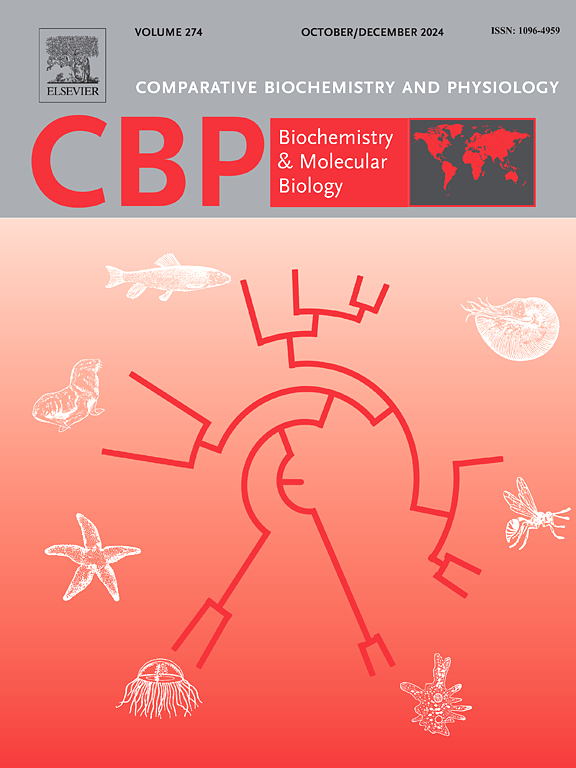Conjugated linoleic acid regulation of fatty acid metabolism by mTOR signaling pathway in grass carp (Ctenopharyngodon idella) adipocytes
IF 1.8
3区 生物学
Q4 BIOCHEMISTRY & MOLECULAR BIOLOGY
Comparative Biochemistry and Physiology B-Biochemistry & Molecular Biology
Pub Date : 2025-08-11
DOI:10.1016/j.cbpb.2025.111145
引用次数: 0
Abstract
The purpose of this study was to investigate the effects of conjugated linoleic acid (CLA) on fatty acid metabolism through the mammalian target of rapamycin (mTOR) signaling pathway in grass carp (Ctenopharyngodon idella) adipocytes. Grass carp preadipocytes were cultured and treated with various concentrations of CLA (0, 50, 100, 150 and 200 μmol/L). Lipid accumulation was assessed using Oil Red O staining. The regulatory effects on mTOR signaling pathway were evaluated using real-time quantitative PCR (RT-qPCR) and Western Blot (WB). CLA treatment significantly inhibited lipid accumulation and downregulated the expression of genes related to de novo fatty acid synthesis, including fatty acid synthase (fas), acetyl-CoA carboxylase (acc), stearoyl-CoA desaturase 1 (scd1), and sterol regulatory element binding protein-1c (srebp-1c). In contrast, the expression of genes related to fatty acid transport and β-oxidation, such as carnitine palmitoyl transferase-1α (cpt-1α) and hormone-sensitive lipase (hsl), was upregulated. These regulatory effects were found to be concentration-dependent. Co-treatment with the mTOR inhibitor rapamycin further suppressed the mRNA expression of srebp-1c, fas and acc. Furthermore, CLA reduced the protein expression levels of mTOR and nuclear sterol regulatory element-binding protein 1 (nSrebp1), while exerting minimal effect on phosphorylated mTOR (p-mTOR). In summary, CLA appears to modulate lipid metabolism in grass carp adipocytes by inhibiting srebp-1c within the mTOR signaling pathway.

偶联亚油酸通过mTOR信号通路调控草鱼脂肪细胞脂肪酸代谢。
本研究旨在探讨共轭亚油酸(CLA)通过哺乳动物雷帕霉素(mTOR)信号通路对草鱼脂肪细胞脂肪酸代谢的影响。用不同浓度的CLA(0、50、100、150和200 μmol/L)培养草鱼前脂肪细胞。油红O染色检测脂质积累。采用实时荧光定量PCR (RT-qPCR)和Western Blot (WB)方法评价其对mTOR信号通路的调控作用。CLA处理显著抑制脂肪积累,下调脂肪酸合成相关基因的表达,包括脂肪酸合成酶(fas)、乙酰辅酶a羧化酶(acc)、硬脂酰辅酶a去饱和酶1 (scd1)和甾醇调节元件结合蛋白-1c (srebp-1c)。相反,与脂肪酸转运和β-氧化相关的基因,如肉碱棕榈酰转移酶-1α (cpt-1α)和激素敏感脂肪酶(hsl)的表达上调。发现这些调节作用是浓度依赖性的。与mTOR抑制剂雷帕霉素联合治疗进一步抑制srebp-1c、fas和acc的mRNA表达。此外,CLA降低了mTOR和核固醇调控元件结合蛋白1 (nSrebp1)的蛋白表达水平,而对磷酸化mTOR (p-mTOR)的影响很小。综上所述,CLA似乎通过抑制mTOR信号通路中的srebp-1c来调节草鱼脂肪细胞的脂质代谢。
本文章由计算机程序翻译,如有差异,请以英文原文为准。
求助全文
约1分钟内获得全文
求助全文
来源期刊
CiteScore
4.60
自引率
4.50%
发文量
77
审稿时长
22 days
期刊介绍:
Comparative Biochemistry & Physiology (CBP) publishes papers in comparative, environmental and evolutionary physiology.
Part B: Biochemical and Molecular Biology (CBPB), focuses on biochemical physiology, primarily bioenergetics/energy metabolism, cell biology, cellular stress responses, enzymology, intermediary metabolism, macromolecular structure and function, gene regulation, evolutionary genetics. Most studies focus on biochemical or molecular analyses that have clear ramifications for physiological processes.

 求助内容:
求助内容: 应助结果提醒方式:
应助结果提醒方式:


